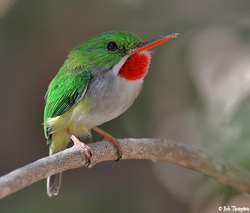 Puerto Rican Tody - ADORABLE
Puerto Rican Tody - ADORABLE The Sociedad Ornitológica Puertorriqueña (SOPI, BirdLife in Puerto Rico) has signed an agreement with Cafiesencia, a local NGO, to collaborate in promoting economic sustainability and biodiversity conservation through the production of "Ecological Shade-grown Coffee" in the Important Bird and Biodiversity Area (IBA) of Maricao and Susua in Puerto Rico.
Maricao and Susua IBA is home to the globally threatened Puerto Rican Nightjar (Caprimulgus noctitherus) and Elfin-woods Warbler (Setophaga angelae). It also supports populations of many Neotropical migratory birds, and 18 restricted-range species including the Puerto Rican Tody (Todus mexicanus), which is the charismatic species featured on the branding of coffee being produced by participating farmers. The IBA is also recognized as a Key Biodiversity Area in recognition of its importance for plants, bats, reptiles and amphibians.
The Shade-grown Coffee Round Table is made up of representatives from national and federal government, NGOs and farmers, and is developing the criteria for certification of the ecological shade-grown coffee. They have identified a niche for an organization with expertise in bird conservation and agri-tourism to develop workshops for farmers, establish bird monitoring plots and train farmers in birdwatching. With this niche in mind, Cafiesencia, the leading NGO of the Round Table, has invited SOPI to participate in this initiative and start by establishing of bird monitoring plots. By signing this agreement, both organizations will work with coffee-farming communities to implement best practices that benefit birds, the forests and people. "It is important to maintain agriculture and conservation in harmony as they will both benefit each other in the long term," said Lisette Fas, Executive Director of Cafiescencia.
SOPI is supporting the production and marketing of this shade-grown coffee as it represents an important means of conserving birds (through the maintenance of the shade-providing canopy trees) and securing a premium price, thereby improving the livelihoods of the farmers. Ela M. Cruz, SOPI's Executive Director, said: "If the recommended best practices are adopted by the farmers, these farms will provide excellent buffer zones and wildlife corridors to the adjacent protected areas, and protect an important watershed. In return, the biodiversity — including the birds — will provide pest control and pollination services, and the coffee that is produced will command a premium price." In parallel to working on best practices, SOPI will also promote birding in these farms as an additional income-generating activity which will reinforce this production system as a win-win for both the farmers and biodiversity.
For more information about SOPI's conservation work, please visit their website atwww.avesdepuertorico.org.
Maricao and Susua IBA is home to the globally threatened Puerto Rican Nightjar (Caprimulgus noctitherus) and Elfin-woods Warbler (Setophaga angelae). It also supports populations of many Neotropical migratory birds, and 18 restricted-range species including the Puerto Rican Tody (Todus mexicanus), which is the charismatic species featured on the branding of coffee being produced by participating farmers. The IBA is also recognized as a Key Biodiversity Area in recognition of its importance for plants, bats, reptiles and amphibians.
The Shade-grown Coffee Round Table is made up of representatives from national and federal government, NGOs and farmers, and is developing the criteria for certification of the ecological shade-grown coffee. They have identified a niche for an organization with expertise in bird conservation and agri-tourism to develop workshops for farmers, establish bird monitoring plots and train farmers in birdwatching. With this niche in mind, Cafiesencia, the leading NGO of the Round Table, has invited SOPI to participate in this initiative and start by establishing of bird monitoring plots. By signing this agreement, both organizations will work with coffee-farming communities to implement best practices that benefit birds, the forests and people. "It is important to maintain agriculture and conservation in harmony as they will both benefit each other in the long term," said Lisette Fas, Executive Director of Cafiescencia.
SOPI is supporting the production and marketing of this shade-grown coffee as it represents an important means of conserving birds (through the maintenance of the shade-providing canopy trees) and securing a premium price, thereby improving the livelihoods of the farmers. Ela M. Cruz, SOPI's Executive Director, said: "If the recommended best practices are adopted by the farmers, these farms will provide excellent buffer zones and wildlife corridors to the adjacent protected areas, and protect an important watershed. In return, the biodiversity — including the birds — will provide pest control and pollination services, and the coffee that is produced will command a premium price." In parallel to working on best practices, SOPI will also promote birding in these farms as an additional income-generating activity which will reinforce this production system as a win-win for both the farmers and biodiversity.
For more information about SOPI's conservation work, please visit their website atwww.avesdepuertorico.org.
 RSS Feed
RSS Feed